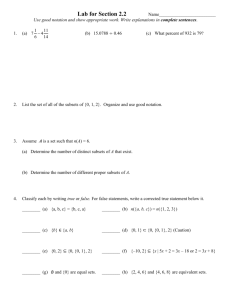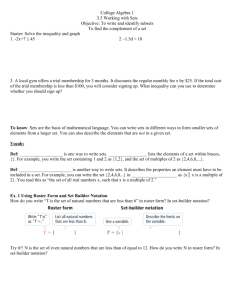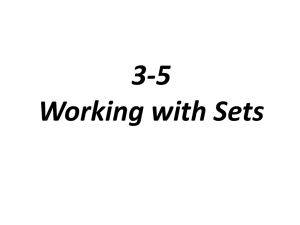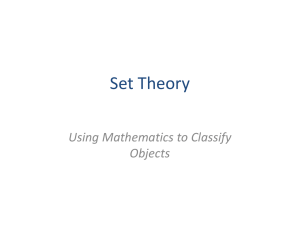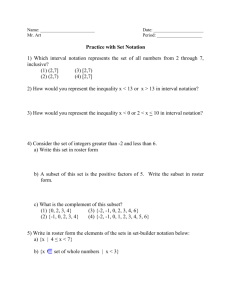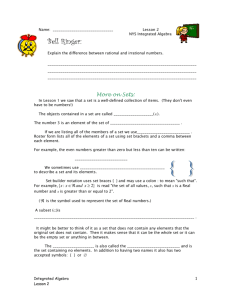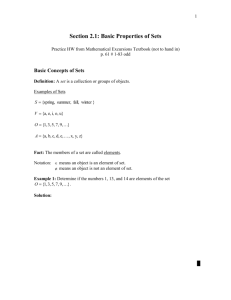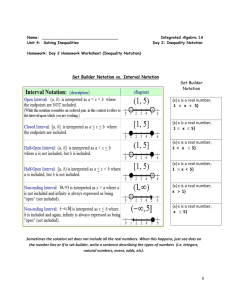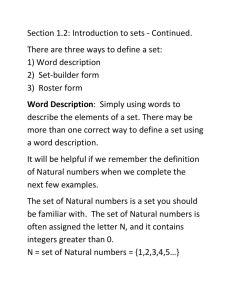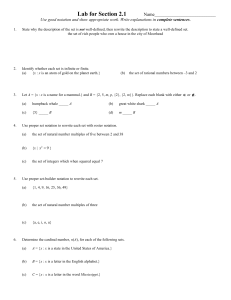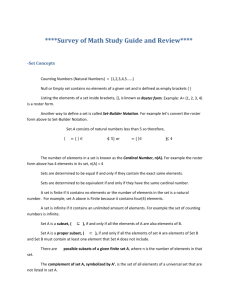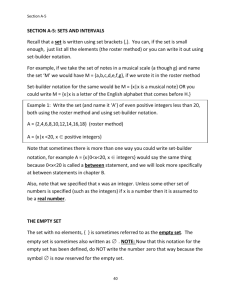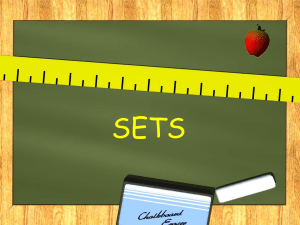Lesson 3-5
advertisement
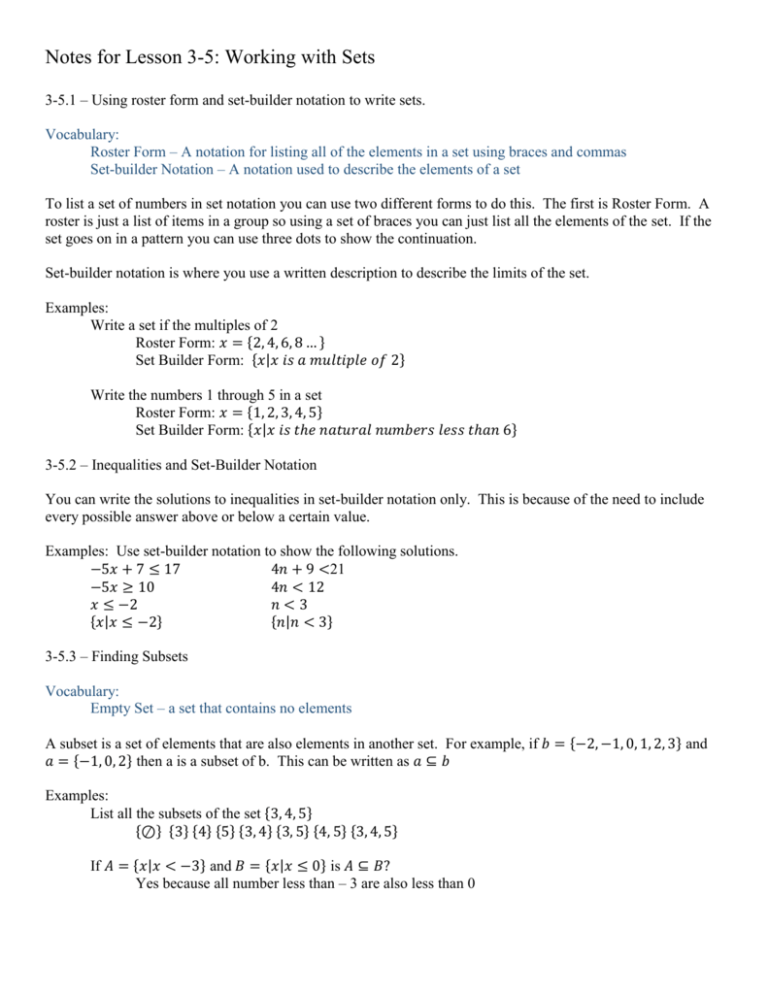
Notes for Lesson 3-5: Working with Sets
3-5.1 – Using roster form and set-builder notation to write sets.
Vocabulary:
Roster Form – A notation for listing all of the elements in a set using braces and commas
Set-builder Notation – A notation used to describe the elements of a set
To list a set of numbers in set notation you can use two different forms to do this. The first is Roster Form. A
roster is just a list of items in a group so using a set of braces you can just list all the elements of the set. If the
set goes on in a pattern you can use three dots to show the continuation.
Set-builder notation is where you use a written description to describe the limits of the set.
Examples:
Write a set if the multiples of 2
Roster Form: 𝑥 = {2, 4, 6, 8 … }
Set Builder Form: {𝑥|𝑥 𝑖𝑠 𝑎 𝑚𝑢𝑙𝑡𝑖𝑝𝑙𝑒 𝑜𝑓 2}
Write the numbers 1 through 5 in a set
Roster Form: 𝑥 = {1, 2, 3, 4, 5}
Set Builder Form: {𝑥|𝑥 𝑖𝑠 𝑡ℎ𝑒 𝑛𝑎𝑡𝑢𝑟𝑎𝑙 𝑛𝑢𝑚𝑏𝑒𝑟𝑠 𝑙𝑒𝑠𝑠 𝑡ℎ𝑎𝑛 6}
3-5.2 – Inequalities and Set-Builder Notation
You can write the solutions to inequalities in set-builder notation only. This is because of the need to include
every possible answer above or below a certain value.
Examples: Use set-builder notation to show the following solutions.
−5𝑥 + 7 ≤ 17
4𝑛 + 9 <21
−5𝑥 ≥ 10
4𝑛 < 12
𝑥 ≤ −2
𝑛<3
{𝑥|𝑥 ≤ −2}
{𝑛|𝑛 < 3}
3-5.3 – Finding Subsets
Vocabulary:
Empty Set – a set that contains no elements
A subset is a set of elements that are also elements in another set. For example, if 𝑏 = {−2, −1, 0, 1, 2, 3} and
𝑎 = {−1, 0, 2} then a is a subset of b. This can be written as 𝑎 ⊆ 𝑏
Examples:
List all the subsets of the set {3, 4, 5}
{⊘} {3} {4} {5} {3, 4} {3, 5} {4, 5} {3, 4, 5}
If 𝐴 = {𝑥|𝑥 < −3} and 𝐵 = {𝑥|𝑥 ≤ 0} is 𝐴 ⊆ 𝐵?
Yes because all number less than – 3 are also less than 0
3-5.4 – Finding the complement of a set.
Vocabulary:
Universal Set – The set of all possible elements from which a subset is formed.
Complement of a Set – The set of all elements in a universal set that are not in a given set
The complete of a set is the remaining members of a universal set after you have identified a subset. For
example if the universal set is the integers and the subset is the positives then the complement would be the set
of zero and the negatives. 𝑈 = {𝑥|𝑥 = 𝑎𝑙𝑙 𝑖𝑛𝑡𝑒𝑔𝑒𝑟𝑠} 𝐴 = {𝑥|𝑥 = 𝑝𝑜𝑠𝑖𝑡𝑖𝑣𝑒𝑠} 𝑡ℎ𝑒𝑛 𝐴′ =
{𝑥|𝑥 = 𝑧𝑒𝑟𝑜 𝑎𝑛𝑑 𝑛𝑒𝑔𝑎𝑡𝑖𝑣𝑒𝑠}
Examples:
If 𝑈 = {𝑥|𝑥 = 𝑚𝑜𝑛𝑡ℎ𝑠 𝑜𝑓 𝑦𝑒𝑎𝑟} 𝑎𝑛𝑑 𝐴 = {𝑥|𝑥 = 𝑚𝑜𝑛𝑡ℎ𝑠 𝑤𝑖𝑡ℎ 31 𝑑𝑎𝑦𝑠} 𝑡ℎ𝑒𝑛 𝐴′ =
{𝑥|𝑥 = 𝑚𝑜𝑛𝑡ℎ𝑠 𝑤𝑖𝑡ℎ 𝑙𝑒𝑠𝑠 𝑡ℎ𝑎𝑛 31 𝑑𝑎𝑦𝑠}
If 𝑈 = {𝑥|𝑥 = 𝑠𝑡𝑎𝑛𝑑𝑎𝑟𝑑 𝑑𝑒𝑐𝑘 𝑜𝑓 𝑐𝑎𝑟𝑑𝑠} 𝑎𝑛𝑑 𝐴 = {𝑥|𝑥 = 𝐶𝑎𝑟𝑑𝑠 𝑣𝑎𝑙𝑢𝑒𝑑 𝑎𝑡 10} 𝐴′ =
{𝑥|𝑥 = 2 − 9′ 𝑠 𝑎𝑛𝑑 𝑎𝑐𝑒𝑠}
